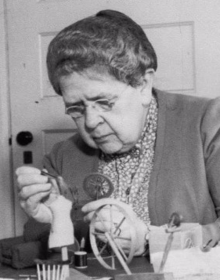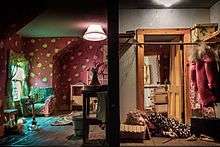Frances Glessner Lee
Frances Glessner Lee (March 25, 1878 – January 27, 1962) was an American forensic scientist. She was influential in developing the science of forensics in the United States.[1] To this end, she created the Nutshell Studies of Unexplained Death, 20 true crime scene dioramas recreated in minute detail at dollhouse scale, used for training homicide investigators. Eighteen of the Nutshell Studies of Unexplained Death are still in use for teaching purposes by the Maryland Office of the Chief Medical Examiner, and the dioramas are also now considered works of art.[2] Lee also helped to establish the Department of Legal Medicine at Harvard, and endowed the Magrath Library of Legal Medicine there.[3] She became the first female police captain in the United States, and is known as the "mother of forensic science".[4][5]
Frances Glessner Lee | |
|---|---|
 | |
| Born | March 25, 1878 |
| Died | January 27, 1962 (aged 83) |
| Nationality | American |
| Known for | "Mother of forensic science" |
Notable work | Nutshell Studies of Unexplained Death |
| Spouse(s) | Blewett Harrison Lee |
Personal life
Lee was born in Chicago on March 25, 1878.[6] Her father, John Jacob Glessner, was an industrialist who became wealthy from International Harvester.[7][8] She and her brother were educated at home; her brother went to Harvard.[9] She married a lawyer, Blewett Harrison Lee. The marriage ended in divorce.[8] In the early 1930s she began a career in legal medicine. She inherited the Harvester fortune and she finally had the money to develop an interest in how detectives could examine clues.[10]
Personal notes
Lee's perfectionism and dioramas reflect her family background.[11] Her father was an avid collector of fine furniture, with which he furnished the family home. He wrote a book on the subject, and the family home, designed by Henry Hobson Richardson,[8] is now the John J. Glessner House museum. Glessner Lee was fond of the stories of Sherlock Holmes,[12] whose plot twists were often the result of overlooked details.[13]
Career
Lee was inspired by a classmate of her brother's, George Burgess Magrath. He was studying medicine at Harvard Medical School and was particularly interested in death investigation.[8][14] They remained close friends until his death in 1938. Magrath became a chief medical examiner in Boston and together they lobbied to have coroners replaced by medical professionals. Glessner Lee endowed the Harvard Department of Legal Medicine (in 1931, the first such department in the country), and the George Burgess Magrath Library.[8][15] She also endowed the Harvard Associates in Police Science, a national organization for the furtherance of forensic science that has a division dedicated to her, called the Frances Glessner Lee Homicide School.[8] The Harvard program influenced other states to change over from the coroner system.
Nutshell Studies of Unexplained Death

Through the 1940s and 1950s, Lee hosted a series of semi-annual seminars in homicide investigation. Detectives, prosecutors, and other investigators were invited to a week-long conference, where she presented them with the "Nutshell Studies of Unexplained Death", intricately constructed dioramas of actual crime scenes, complete with working doors, windows and lights.[8] The 20 models were based on challenging cases and were designed to test the abilities of students to collect all relevant evidence. The models depicted multiple causes of death, and were based on autopsies and crime scenes that Lee visited.
She paid extraordinary attention to detail in creating the models. The rooms were filled with working mousetraps and rocking chairs, food in the kitchens, and more, and the corpses accurately represented discoloration or bloating that would be present at the crime scene. Each model cost about $3,000-$4,500 to create.[16] Students were given 90 minutes to study the scene. The week culminated in a banquet at the Ritz Carlton.[8][15] Eighteen of the original dioramas are still used for training purposes by Harvard Associates in Police Science.[17]
For her work, Lee was made an honorary captain in the New Hampshire State Police on October 27, 1943, making her the first woman to join the International Association of Chiefs of Police.[3][16][17]°
In popular culture
_02.jpg)
- Frances Glessner Lee's biography, 18 Tiny Deaths: The Untold Story of Frances Glessner Lee and the Invention of Modern Forensics, by Bruce Goldfarb, was released by Sourcebooks on February 4, 2020.[18]
- The Nutshell Studies of Unexplained Death provided the inspiration for the Miniature Killer in the television show CSI: Crime Scene Investigation.[19]
- Glessner Lee is paid tribute to in the award-winning hard-cover book Encyclopedia Horrifica by Joshua Gee.[20]
- Frances Glessner Lee and Erle Stanley Gardner were friends, and he dedicated several of his detective novels to her, including The Case of the Dubious Bridegroom.[2][21]
- The character of Agnes Lesser in the Father Brown episode "The Smallest of Things" is based on Glessner Lee.[22]
- The Renwick Gallery of the Smithsonian American Art Museum exhibited 18 of the Nutshell Studies of Unexplained Death from October 20, 2017 to January 28, 2018. Sponsors included the American Academy of Forensic Sciences.[4]
- On November 18, 2017, the film Murder in a Nutshell: The Frances Glessner Lee Story, directed by Susan Marks, premiered at the Renwick Gallery, followed by a moderated discussion with filmmaker.[23]
- Frances Glessner Lee and her pioneering work with crime scene dioramas is cited in some detail and plays a crucial role in episode 17 of the 17th season of NCIS[24], "In a Nutshell"[25].
See also
- New Hampshire Historical Marker No. 257: Frances Glessner Lee (1878–1962) 'Mother of Forensic Science'
References
- Goldfarb, Bruce (2020). 18 tiny deaths : the untold story of Frances Glessner Lee and the invention of modern forensics. Naperville, Illinois. ISBN 978-1-4926-8047-5. OCLC 1096529139.
- Hamilton, William L. (2018). "Heiress Plotted 19 Grisly Crimes. Investigation Underway". The New York Times. ISSN 0362-4331. Retrieved February 4, 2018.
- "Visible Proofs: Forensic Views of the Body: Biographies: Frances Glessner Lee (1878–1962)". United States National Library of Medicine. Retrieved February 4, 2018.
- "Murder Is Her Hobby: Frances Glessner Lee and The Nutshell Studies of Unexplained Death". Smithsonian American Art Museum. Retrieved February 4, 2018.
- Main, Douglas (June 10, 2014). "The 'Mother Of Forensic Science' Built Dollhouse Crime Scenes". Popular Science. Retrieved February 4, 2018.
- Botz, Corinne. The Nutshell Studies of Unexplained Death, The Monacelli Press (2004), p. 18.
- Kahn, Eve, Murder Downsized (7 Oct 2004), The New York Times.
- Laura J. Miller, "Frances Glessner Lee: Brief life of a forensic miniaturist: 1878–1962", Harvard Magazine September–October 2005.
- Goldfarb, Bruce (2020). 18 tiny deaths : the untold story of Frances Glessner Lee and the invention of modern forensics. Naperville, Illinois. ISBN 978-1-4926-8047-5. OCLC 1096529139.
- "The People". Glessner House Museum. Retrieved March 31, 2016.
- Botz, Corinne. The Nutshell Studies of Unexplained Death, The Monacelli Press (2004).
- Horowitz-Ghazi, Alexi (November 18, 2017). "The Tiny, Murderous World Of Frances Glessner Lee". National Public Radio. Retrieved February 4, 2018.
- Townsend, Catherine (March 28, 2017). "A Look Back At The "Mother Of Forensic Science" And Her Dollhouses Of Death - CrimeFeed". CrimeFeed. Retrieved February 4, 2018.
- Katherine Ramsland, The Nutshell Studies of Frances Glessner Lee Archived January 25, 2007, at the Wayback Machine, TruTV.com.
- "The Nutshell Studies of Unexplained Death," Archived July 25, 2016, at the Wayback Machine from American Medical News, August 17, 1992, archived at brucegoldfarb.com, retrieved February 4, 2018.
- Nuwer, Rachel (June 9, 2014). "Murder in Miniature". Slate. ISSN 1091-2339. Retrieved March 31, 2016.
- Lisa Respers, "Helping to Crack Cases: 'Nutshells': Miniature replicas of crime scenes from the 1930s and 1940s are used in forensics training", The Baltimore Sun, February 24, 1999.
- Goldfarb, Bruce (2020). 18 tiny deaths : the untold story of Frances Glessner Lee and the invention of modern forensics. Naperville, Illinois. ISBN 978-1-4926-8047-5. OCLC 1096529139.
- Crabtree, Sheigh (May 16, 2007). "The devil is in 'CSI's' details". Los Angeles Times. ISSN 0458-3035. Retrieved February 4, 2018.
- Gee, Joshua (2007). Encyclopedia Horrifica. Scholastic. pp. 127. ISBN 978-0439922555.
- Kennedy, Cray (October 17, 2017). "Frances Glessner Lee and Erle Stanley Gardner". Glessner House Museum.
- "The Smallest of Things". IMDb.
- "Murder in a Nutshell Film Screening". Smithsonian American Art Museum. Retrieved February 4, 2018.
- NCIS (season 17)
- https://www.imdb.com/title/tt11786836/reference
Further reading
- Goldfarb, Bruce. 18 Tiny Deaths: The Untold Story of Frances Glessner Lee and the Invention of Modern Forensics Naperville, IL. Sourcebooks 2020
- Botz, Corinne May. The Nutshell Studies of Unexplained Death. New York: Monacelli, 2004. ISBN 978-1-58093-145-8, OCLC 54826032
- Frank, Priscilla. "How A Doll-Loving Heiress Became The Mother Of Forensic Science". Huffington Post., October 23, 2017.
- Jeltsen, Melissa. "These Bloody Dollhouse Scenes Reveal A Secret Truth About American Crime." Huffington Post, February 2, 2018.
- Rosberg, Gerald M. "A Colloquium on Violent Death Brings 30 Detectives to Harvard". The Harvard Crimson, December 6, 1966.
- Uebel, Michael (2017). "Corpus Delicti: Frances Glessner Lee and the Art of Suspicion". Epidemiology and Psychiatric Sciences. 27 (2): 124–126. doi:10.1017/S2045796017000543. PMID 28965511.